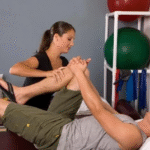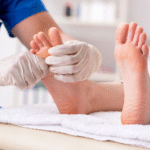
Physical Therapy Exercises for Knee Injury Recovery
September 26, 2025
When to Visit a Podiatrist for Foot Injuries
September 26, 2025
Foot problems can significantly affect daily life, and two of the most common issues people face are bunions and ingrown toenails. These conditions may cause discomfort, pain, and difficulty walking, and if left untreated, they can lead to more serious health concerns. Fortunately, modern podiatry offers effective solutions to manage and even correct these conditions, improving foot health and overall quality of life. In this article, we will explore what bunions and ingrown toenails are, why they occur, and the various podiatry solutions available for them.
Understanding Bunions
A bunion is a bony bump that forms at the base of the big toe, often causing the toe to lean toward the other toes. This misalignment can lead to pain, swelling, and difficulty wearing certain types of shoes. Bunions often develop gradually and may be influenced by genetics, improper footwear, or structural problems in the foot.
Causes of Bunions
- Genetics – If your family has a history of bunions, you may be more prone to developing them.
- Footwear – Tight, narrow, or high-heeled shoes can place pressure on the toes and contribute to bunion formation.
- Arthritis – Conditions like osteoarthritis can weaken the joints and lead to bunions.
- Foot structure – Flat feet, abnormal bone structure, or excessive pronation (foot rolling inward) can increase the risk.
Symptoms of Bunions
- Swelling or redness around the big toe joint
- Pain while walking or standing for long periods
- Thickened skin over the affected area
- Restricted movement of the toe
Understanding Ingrown Toenails
An ingrown toenail occurs when the edge of a toenail grows into the surrounding skin, causing pain, swelling, and sometimes infection. This condition most commonly affects the big toe and can make walking uncomfortable. Ingrown toenails are often preventable, but they can also result from improper nail trimming, trauma, or hereditary factors.
Causes of Ingrown Toenails
- Improper nail trimming – Cutting nails too short or rounding the edges can encourage them to grow into the skin.
- Tight footwear – Shoes that press on the toes can increase the likelihood of ingrown nails.
- Injury – Stubbing the toe or repetitive trauma can cause nails to grow abnormally.
- Genetics – Naturally curved toenails may be more likely to become ingrown.
Symptoms of Ingrown Toenails
- Pain or tenderness along the side of the nail
- Redness and swelling around the nail
- Infection or pus in severe cases
- Difficulty wearing shoes or walking comfortably
Podiatry Solutions for Bunions
Podiatrists provide both non-surgical and surgical treatments for bunions depending on severity and patient needs.
Non-Surgical Solutions
- Footwear adjustments – Wearing wide-toed shoes with low heels can reduce pressure on the bunion.
- Orthotic devices – Custom shoe inserts can help correct abnormal foot mechanics and reduce discomfort.
- Padding and splints – Bunion pads or toe spacers can protect the affected area and relieve pain.
- Medication – Over-the-counter anti-inflammatory drugs can help manage pain and swelling.
- Physical therapy – Exercises that strengthen the foot muscles and improve alignment can slow bunion progression.
Surgical Solutions
If conservative treatments are insufficient, bunion surgery (bunionectomy) may be recommended. The procedure involves realigning the toe joint, removing excess bone, and restoring proper function. Modern surgical techniques offer shorter recovery times and less post-operative discomfort.
Podiatry Solutions for Ingrown Toenails
Treatment for ingrown toenails varies depending on severity. Early intervention is crucial to prevent infection.
Non-Surgical Solutions
- Proper nail care – Trimming nails straight across and avoiding sharp edges can prevent recurrence.
- Soaking and cleaning – Soaking the foot in warm water can reduce swelling and relieve pain.
- Antibiotics – If an infection is present, topical or oral antibiotics may be prescribed.
- Protective devices – Cotton wedges or special toenail braces can lift the nail edge and promote proper growth.
Surgical Solutions
In severe or recurrent cases, minor surgical procedures may be necessary:
- Partial nail removal – The ingrown portion of the nail is removed under local anesthesia.
- Matrixectomy – A portion of the nail matrix is removed to prevent regrowth of the problematic nail section.
- Permanent nail correction – Certain techniques prevent the affected nail from growing back into the skin.
Recovery is typically quick, and proper aftercare ensures a reduced risk of recurrence.
Tips for Maintaining Healthy Feet
- Choose proper footwear – Shoes should fit well and provide enough room for toes.
- Practice good nail care – Trim nails straight across and avoid cutting too short.
- Monitor foot health – Regularly check for signs of bunions, ingrown toenails, or other foot problems.
- Exercise regularly – Strengthening foot muscles can improve overall foot alignment.
- Consult a podiatrist – Seek professional care early to prevent minor issues from becoming serious.
FAQs About Bunions and Ingrown Toenails
1. Can bunions be prevented?
Yes, choosing proper footwear, maintaining foot strength, and addressing foot alignment issues early can help prevent bunions.
2. Are bunion pads effective?
Bunion pads provide temporary relief by cushioning the area and reducing friction, but they do not correct the deformity.
3. Can ingrown toenails recur after surgery?
Recurrence is possible but rare if the nail is properly treated and proper foot care is maintained.
4. Is it safe to soak a foot with an ingrown toenail?
Yes, soaking in warm water 2-3 times a day can reduce swelling and pain, but it should be combined with proper nail care.
5. How soon can I walk after bunion surgery?
Depending on the procedure, many patients can walk within a few days using special footwear or crutches, but full recovery may take several weeks.
Conclusion
Bunions and ingrown toenails are common foot problems that can cause significant discomfort. Thankfully, podiatry provides a wide range of solutions—from non-surgical treatments like orthotics, proper footwear, and nail care to surgical interventions for more severe cases. Early detection, proper foot care, and professional guidance are key to managing these conditions effectively. By taking proactive steps, you can maintain healthy, pain-free feet and enjoy a better quality of life.

